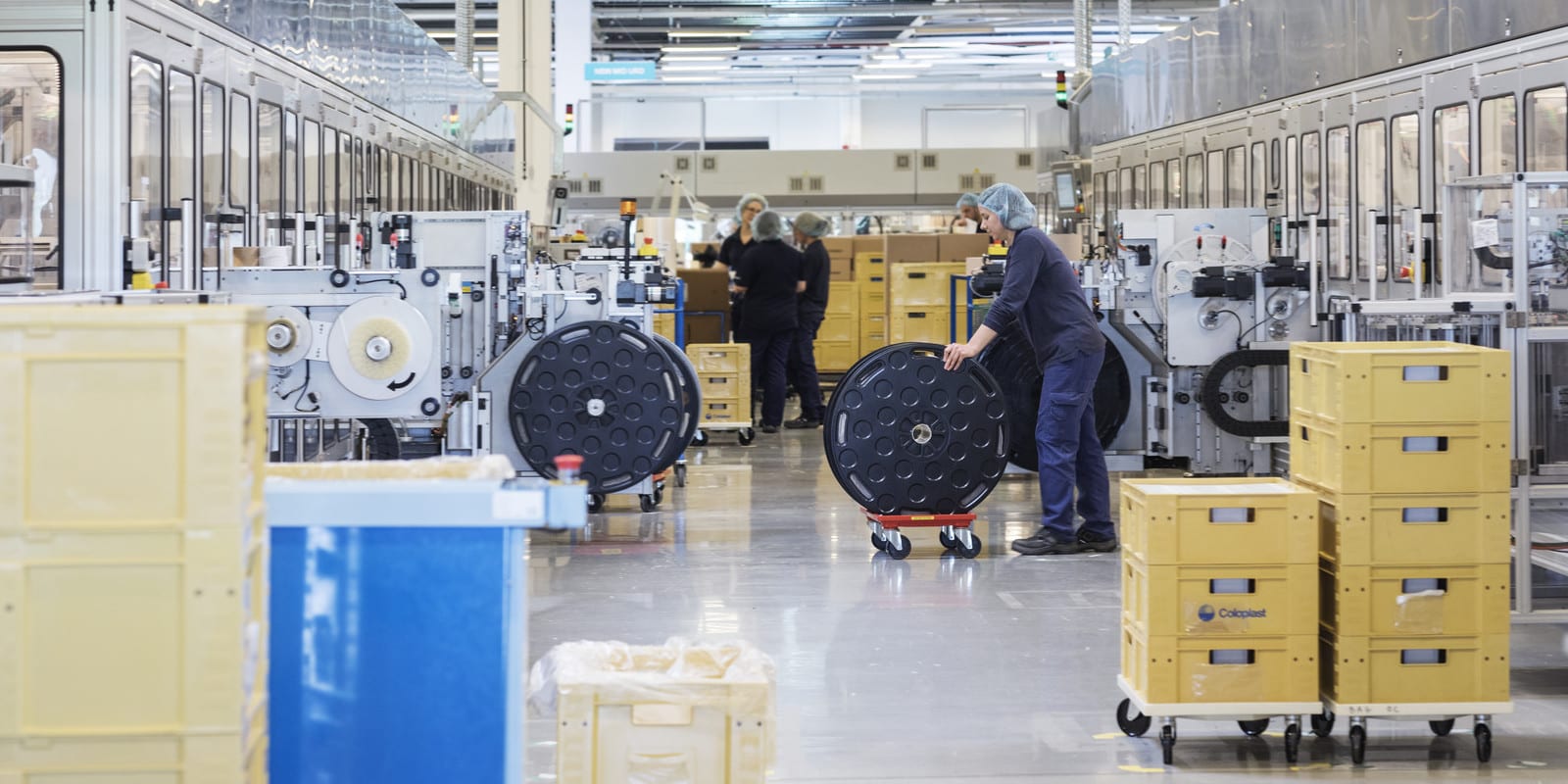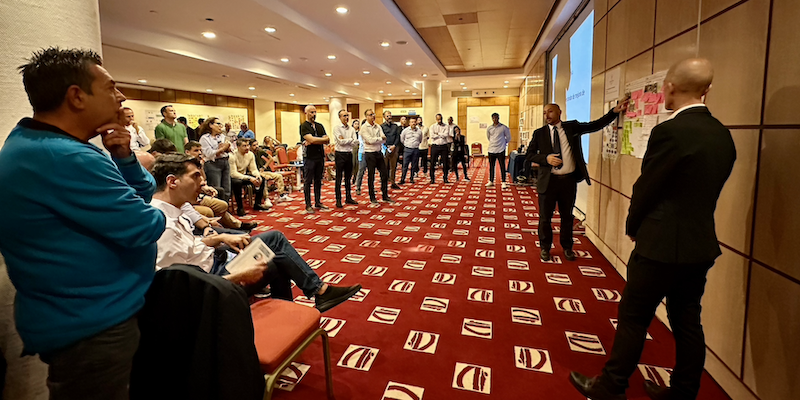
How the French Post helps lean thinking reach every employee
INTERVIEW – How do you communicate a consistent message to thousands of employees working across a fragmented and extremely diverse network? Catherine Blay, from French postal service La Poste, tells us.
Interviewee: Catherine Blay, Director of ELAN approach, La Poste
Planet Lean: La Poste just celebrated its 1000th kaizen event. Tell us about it, please.
Catherine Blay: The specific event was about helping our mailmen to master the use of the smartphones we had provided them with. It took the form of a dojo meant to teach our people new standards: how to connect to wi-fi networks, how to send information back to the system, what to do when coming back from the field, and so on.
The introduction of smartphones was an important strategic move for us. We are responding to new customer expectations by offering new services that capitalize on the values of La Poste (such as trust and proximity). Smartphones can help us a lot with that, making the delivery of services faster. In that sense, the 1000th kaizen event was particularly meaningful.
PL: The Director General attended as well – does that happen often?
CB: The Director General is our sponsor, and in fact she goes to the gemba very often. Sometimes it’s for a kaizen event, sometimes just to meet our people or our customers.
She is fully committed to the lean journey, and loves to talk to mailmen early in the morning, with a cup of coffee and some chocolates. She wants to be close to people and to where the work happens.
PL: Can you take us through the lean journey at La Poste?
CB: Sure. It started in 2010, with a project on redesigning the processes in our industrial facility. At the end of the project, we had not achieved the expected quality gains. We faced a gap, and soon figured out that we had to come up with a way to involve people and make them share with one another what we were trying to accomplish.
But we, too, had to understand what we were after. Initially, we were simply trying to optimize our processes. But when it came to the reality of things, we realized that less than 10% of our workforce worked in the industrial facility our project had focused on. What about the remaining 90%? That’s how we got to lean, in 2012. That’s why we chose it. We wanted to find the human element of work that would involve everyone in continuous improvement.
PL: What was holding people back, in your opinion?
CB: People had always taken part in the changes we wanted to implement. But after we automated our processes (for example when our industrial platforms opened), making sense of daily work became more difficult for them.
Things had changed after our processes were automated, especially in how our industrial infrastructure interacts with the delivery function (for instance, mailmen used to sort the post, but not anymore). There was a shift: our processes and our concept of value changed. Everything changed, really, and people had to reconsider what they knew about their jobs.
If we wanted to improve our performance, we had to help them to understand the work again.
PL: What were the main problems you faced in delivery?
CB: The diverse nature of the network and the volumes, without a doubt. There are 4,000 people working across the organization in each territorial Direction, and managing several small units is a challenge. When we try to develop an approach with a manager, we have to do the same again for his or her neighbor, and so on. We have to repeat the same thing over and over again, day after day, site after site.
PL: How do you reach out to so many gembas and bring consistency to the message you communicate?
CB: I wish I had found a magic trick for it! What we did at the beginning was picking a few volunteers and made them our ambassadors.
I now have a team of 40. Each of these people is a lean implementer in each of our 40 territories. Three times a year, through our lean academies, we meet with these 40 people to exchange best practice and experiences. We hold workshops with 10-15 lean implementers and have them work on a specific item, such as hoshin kanri, or dojo.
During those three annual meetings, they receive the general direction of the organization from us. It’s up to them to go back to their operations and apply that vision locally. But they only do it if asked by the manager of the Unit. The chief manager is, and remains, the one who leads.
PL: What about engagement at a more local level? CB: Our lean journey started with pioneers in Northeastern France. That’s where our champions are. In those territories, due to the engagement of the directors, kaizen events are becoming a reflex. People do them almost automatically whenever a problem occurs. And we have started to see a difference in these areas - both in the economic performance and in the way people lead and work together.
It’s something we can show other people in the organization, to facilitate buy-in. But it’s also a promise we make to those people, a promise to help them to improve a KPI they are struggling with, by building a strategic A3 to coordinate the kaizen events in the sites they manage.
PL: What do you do to overcome resistance and how do you improve organizational communication?
CB: If people don’t want to see what lean can bring them, there is no point in showing them. You can lead a horse to water, but you can’t make it drink! That is why we work with volunteers, concentrating on the implementation of kaizen events on the shop floor with mailmen and front line managers. We also train our middle managers and try to get top management to focus on the vital few and lead their teams towards them.
Communication is vital, of course. We had to re-embrace the idea of “flash communication”, the whole briefing-debriefing concept, because so far we have been communicating by sticking Excel files on the walls, written in 11-size font. We have now re-invented team communication with the active support of management.
I’m proud of how we have changed, and I can tell people had been waiting for it: communication today is not just top down. It goes both ways, with mailmen participating and sharing their problems with management. I was surprised at first, because these had not happen in the organization for so many years and we feared nobody would use our boards. But people went back to them with the feeling of having gone back home, which was beautiful to see. We gave our people a way to express their ideas, and they did.
PL: What do you do to reward success? CB: Nothing! We don’t give any rewards because we think that continuous improvement should be a natural part of the work. It should be a daily attitude. But when a group has done well, we ask them to be our ambassadors to another site. It’s not a reward, but it’s professional recognition. People need to be proud of their work.
PL: What are the main challenges of applying lean in an organization like La Poste?
CB: Changing the minds of managers. I think they are afraid, and I always try to find the right words to tell them there is no reason to be.
PL: Can you give us a couple of examples of improvements? How much impact does the level of involvement of leadership have on results? CB: In general, wherever the territorial director is committed, goes to the gemba and practices lean we have good results. In five of our territories, the directors are completely involved and visit a different site each week.
Here’s an example of improvement. One of our territories was struggling with customer claims. The local director asked for help, and said he wanted to decrease claims by 60%. We organized a strategy deployment workshop and a number of related kaizen events, and three weeks later the result had been reached. Sustaining it was a different matter: three weeks later claims were going up again. It turned out the manager had been busy, and had not driven the effort to sustain that result. They re-started, with renewed management support, and achieved the result again. This time, they have sustained it for the past six months. This shows how important the role of management is.
Another example: a client of ours, which was very important for one of our sites, relocated elsewhere, which represented a big loss. The site’s mailmen decided to offset the loss by going out and selling stamps, boxes, and so on. For four months in a row, every week, they sold five times what they used to. Talk about commitment!
PL: What’s next for lean at La Poste?
CB: We have only reached 10% of the managers, so naturally I want that figure to increase. But I would also like to take more top managers through the journey, to show them that there is a different way of doing things.
THE INTERVIEWEE

Read more


INTERVIEW – This cardiac laboratory in Singapore was targeting one improvement and ended up with something different, but equally impactful for its patient flow.


CASE STUDY – The author looks back at the impressive lean transformation of the Hungarian plant of Coloplast, a Danish company offering medical devices and services.


INTERVIEW – In the fall of 1990, a book was published that would kickstart a revolution in business. This week we are catching up with the authors to understand where we are and where we are headed. First up, Daniel Jones.


FEATURE – Our editor attends a Lean Day at Dreamplace Hotels & Resorts in Tenerife. In this report, he shares his thoughts about team building, following up on improvements, and yokoten.

